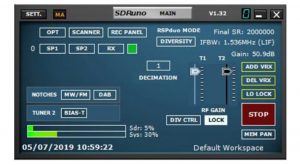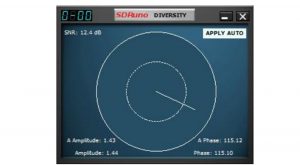Today I put up a second vertical antenna, approximately 13m away from my Wellbrook loop – this equates to roughly a quarter wave of spatial separation for the 49m broadcast band. I wanted to demonstrate the SDRuno diversity software in action. There are a lot of fast changing propagation variables at HF, so it’s easier to demonstrate the diversity MRC (signal enhancement) function with a continuous signal from a broadcast station, rather than hoping an amateur or other comms signal would continue to transmit for long enough to do a comparison.
You can see the noticeable improvement observed: https://youtu.be/GxUOcL8Z0kA
Diversity functionality is described on P.78 of the SDRuno User Manual from which the following is taken:
From V1.32 onwards, MRC (Maximal Ratio Combining) Diversity is supported using the RSPduo. MRC
Diversity can be used to combine the 2 tuner input streams together to potentially improved the SNR
(signal to noise ratio). The same frequency is used for both tuners in the RSPduo and the gain can be
adjusted either on each tuner independently or locked together (the default method).
Diversity mode is enabled by clicking on the RSPduo MODE dropdown and select DIVERSITY. Make sure
both the 50 ohm ports are connected to the correct input source and note that the HiZ port is not available
for Diversity mode. Trying to use the HiZ port will result in an error message being displayed.

Once diversity mode is enabled, the diversity controller window will appear (shown below). This window
shows the current phase and amplitude being applied and the automatic values that are being
continuously calculated and applied (if the APPLY AUTO button is pressed, which is the default mode).
The automatic values have A preceding them in the display.

The automatic mode can be disabled by pressing the APPLY AUTO button and then with the left mouse
button pressed down, select a phase (indicated by the angle in the circle) and an amplitude (indicated by
the length of the line to be applied to the incoming IQ streams.
The result of the combination is sent to the rest of SDRuno as a single IQ stream and so all the post
processing within SDRuno is still fully functional.

